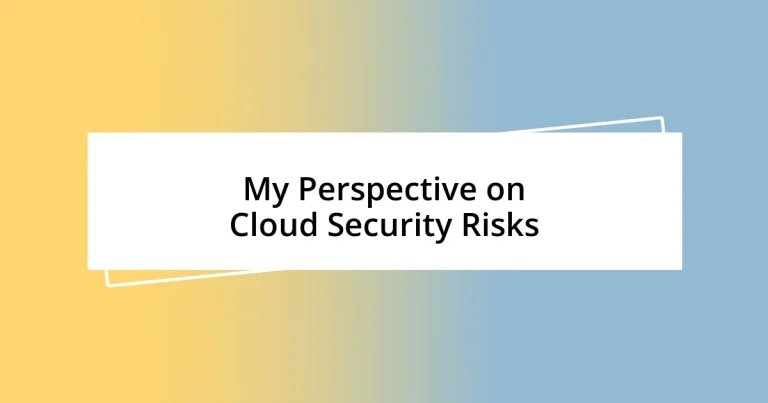Key takeaways:
- Cloud security risks extend beyond technical vulnerabilities, highlighting the importance of user behavior, compliance, and proper governance.
- Common vulnerabilities include misconfiguration, inadequate identity management, and lack of monitoring, which can lead to significant data breaches and reputational damage.
- Future trends in cloud security point towards AI and machine learning integration, zero-trust architecture, and evolving privacy regulations, necessitating proactive approaches to security.
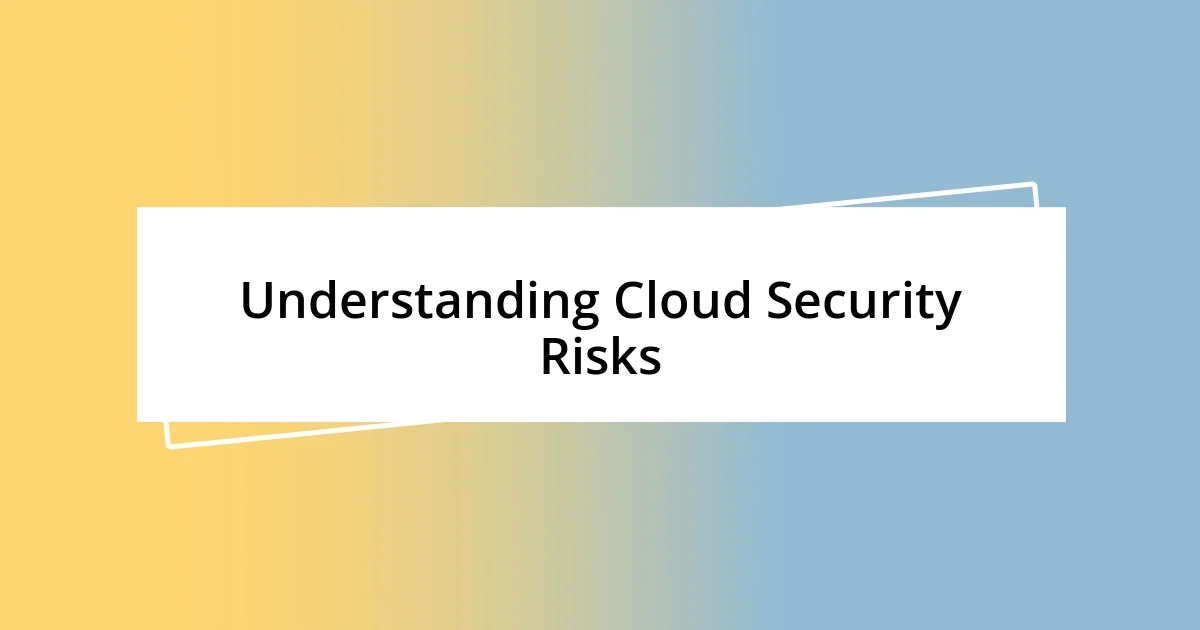
Understanding Cloud Security Risks
When I first started exploring cloud solutions for my projects, I was both excited and anxious about the potential risks involved. It struck me how many businesses overlook the basic fact that the cloud isn’t just an extension of their on-premises environment; it comes with its own unique set of vulnerabilities. Have you ever considered how data breaches can not only compromise sensitive information but can also significantly damage a brand’s reputation?
I experienced this firsthand when a company I worked with faced a data leak due to misconfigured cloud storage settings. It was a wake-up call, highlighting that understanding cloud security risks isn’t just about protecting data; it’s also about grasping the importance of compliance and governance. Mismanagement can lead to expensive penalties and legal complications, which might not seem apparent until it’s too late.
Reflecting on these experiences, I believe that user behavior is another critical aspect of cloud security. Did you know that a large percentage of breaches can be traced back to human error? Whether it’s a simple mistake like sharing passwords or neglecting to apply updates, the effects can ripple out and cause extensive damage. It’s crucial to understand not just the technology involved, but also the people using it, because in the end, awareness and training are often the first lines of defense.
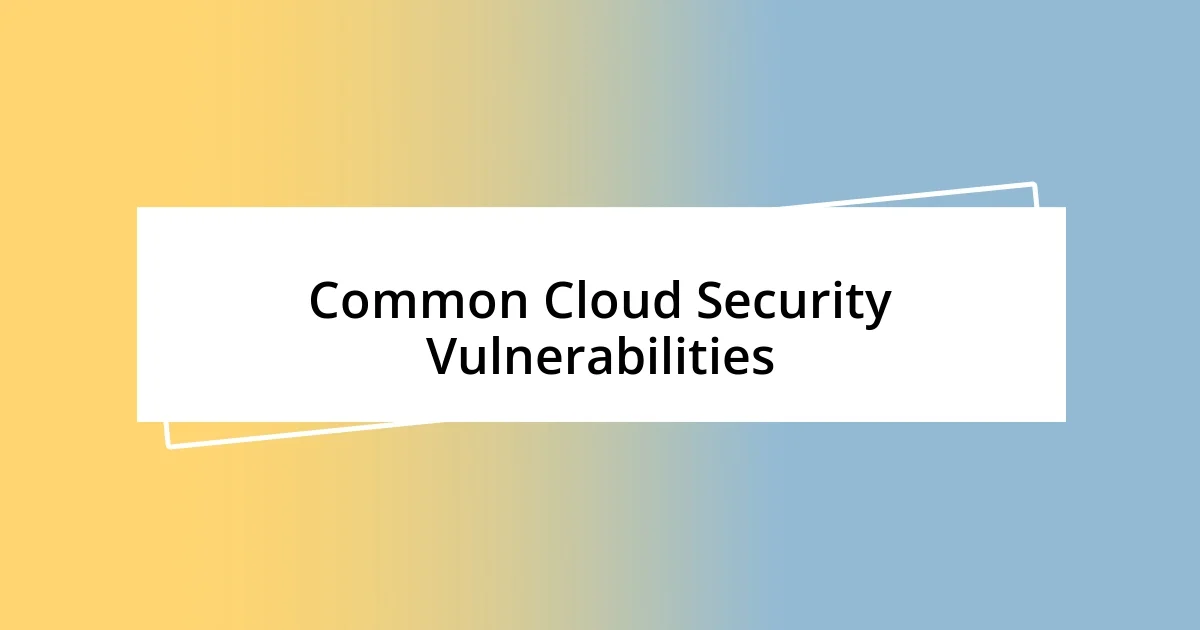
Common Cloud Security Vulnerabilities
When discussing common cloud security vulnerabilities, one major concern is misconfiguration. I’ve seen companies unknowingly expose their data simply because someone neglected to set the right security parameters. This reminds me of a project where I discovered that an entire storage account was left public, allowing anyone to access sensitive documents. It was alarming to think about all that confidential information just floating around.
Another prevalent vulnerability is inadequate identity and access management. I once experienced a scenario where an employee left the organization but their access to the cloud resources wasn’t promptly revoked. This oversight could have allowed ex-employees to maintain access to critical systems, posing a significant risk. Implementing strong authentication methods, such as multi-factor authentication (MFA), is a necessary step to help mitigate such risks.
Lastly, I must mention inadequate monitoring and logging. Without proper tracking, breaches can go unnoticed for far too long. In a particular incident I was involved in, we found that we were blindsided by a data breach because there were no alerts set for suspicious activity. It definitely reinforced my belief that continuous monitoring is essential for maintaining a secure cloud environment.
| Vulnerability | Description |
|---|---|
| Misconfiguration | Improperly set security parameters leading to data exposure |
| Inadequate Identity Management | Failure to revoke access for former employees risking critical data |
| Inadequate Monitoring | Lack of alerts for suspicious activities allowing prolonged breaches |
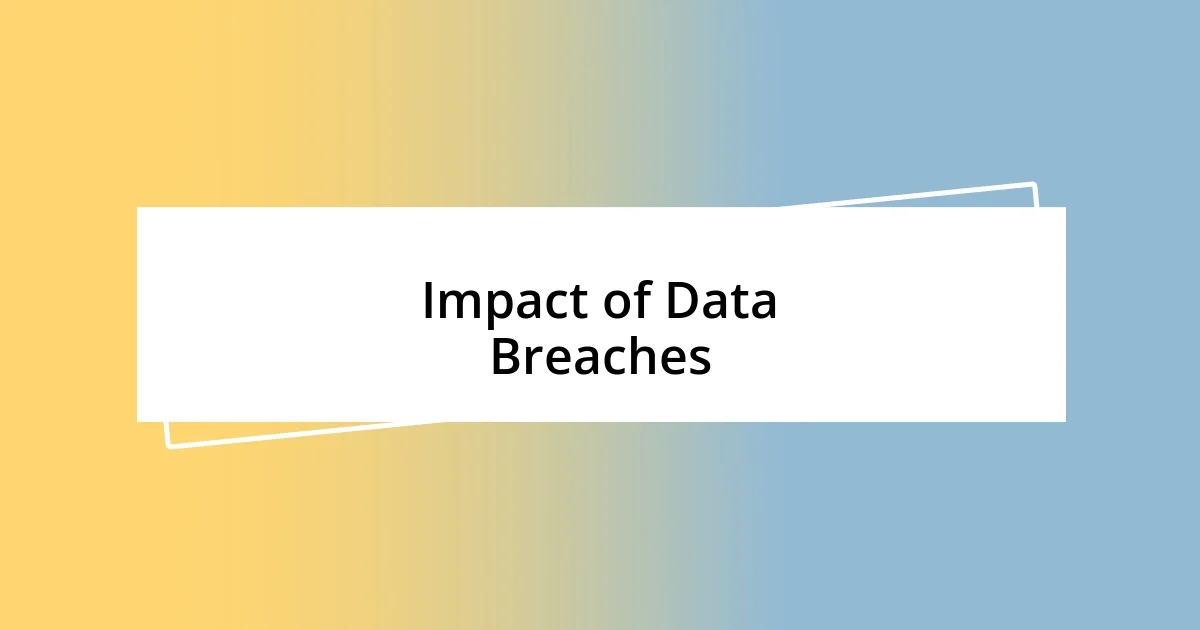
Impact of Data Breaches
Data breaches can have a devastating ripple effect that goes far beyond just the immediate loss of information. I recall a particular instance where a friend’s small business suffered a data breach, and the aftermath was shocking. The financial repercussions were just the tip of the iceberg; they faced a public relations nightmare as customers lost trust in their ability to protect personal data. It’s heart-wrenching to see businesses struggle to rebuild their reputations after such incidents—sometimes taking years to regain customer confidence.
The real impact of data breaches often manifests in several key ways:
- Financial Losses: Companies face direct costs from breach investigations, legal fees, and potential regulatory fines.
- Reputation Damage: Trust, once lost, is challenging to regain; customers may choose competitors over a brand that failed to protect their data.
- Operational Disruption: A breach can lead to unexpected downtime, disrupting regular business processes and resulting in lost revenue.
On another level, the emotional toll on employees can be significant as well. I remember how my friend’s team dealt with stress and anxiety over their job security and the fear of potential layoffs. It’s often the employees who bear the burden of such breaches, feeling the pressure to restore trust and ensure that nothing like it happens again. This emotional aspect of data breaches often gets overlooked, but it’s crucial to acknowledge the collective strain they place on both businesses and their teams.
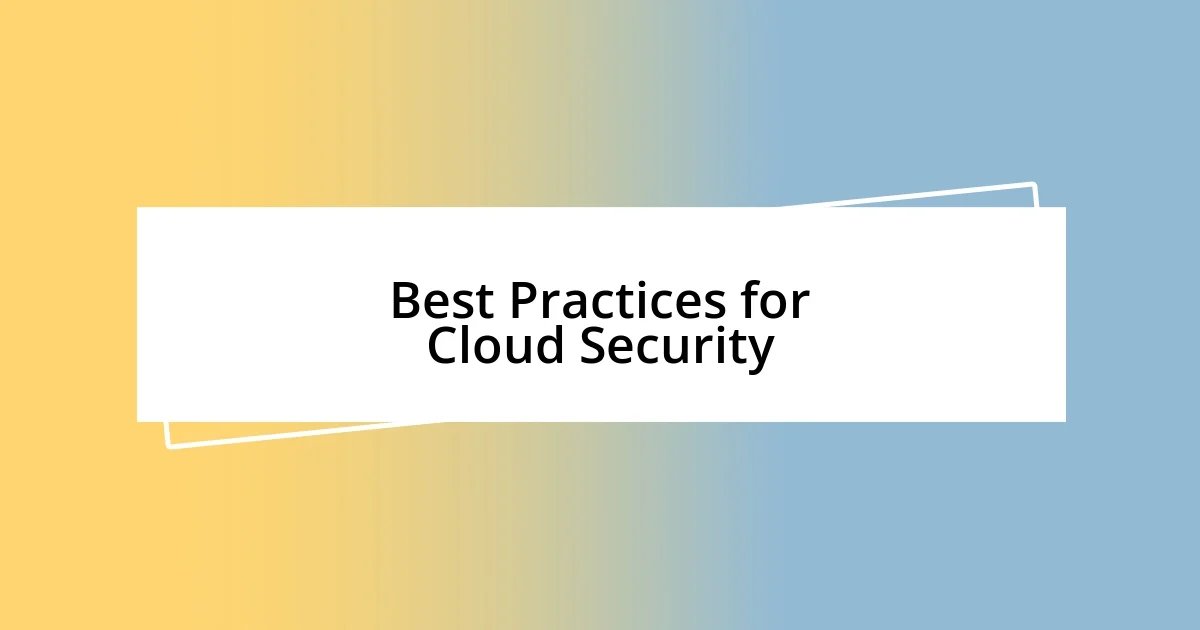
Best Practices for Cloud Security
One of the most effective best practices for cloud security is adopting a robust data encryption strategy. I remember working on a project where we implemented encryption for sensitive client data stored in the cloud. The peace of mind that came from knowing our data was protected—even if accessed by unauthorized users—was priceless. Are we truly taking the necessary steps to safeguard our information? Encryption is not just about keeping data safe; it also helps meet compliance requirements, protecting us from potential legal issues.
Regular backups are another crucial practice I can’t stress enough. During a challenging period at my last job, our systems faced a ransomware attack. I can still recall the frantic feeling in the room as we scrambled to restore lost data. Thankfully, we had a reliable backup strategy in place, which allowed us to recover quickly. It took away some of the panic, knowing we weren’t starting from scratch. Have you considered how your organization would fare during such an event? Regular backups can be a literal lifesaver.
Finally, fostering a culture of security awareness within your team is something that can’t be overlooked. I often find success in using real-life scenarios during training sessions, sharing stories of close calls and near misses. This approach makes the importance of security tangible for team members. Why wait for a security incident to educate your staff? A well-informed team can become your most valuable asset in spotting potential threats before they escalate, creating a proactive rather than reactive security environment.
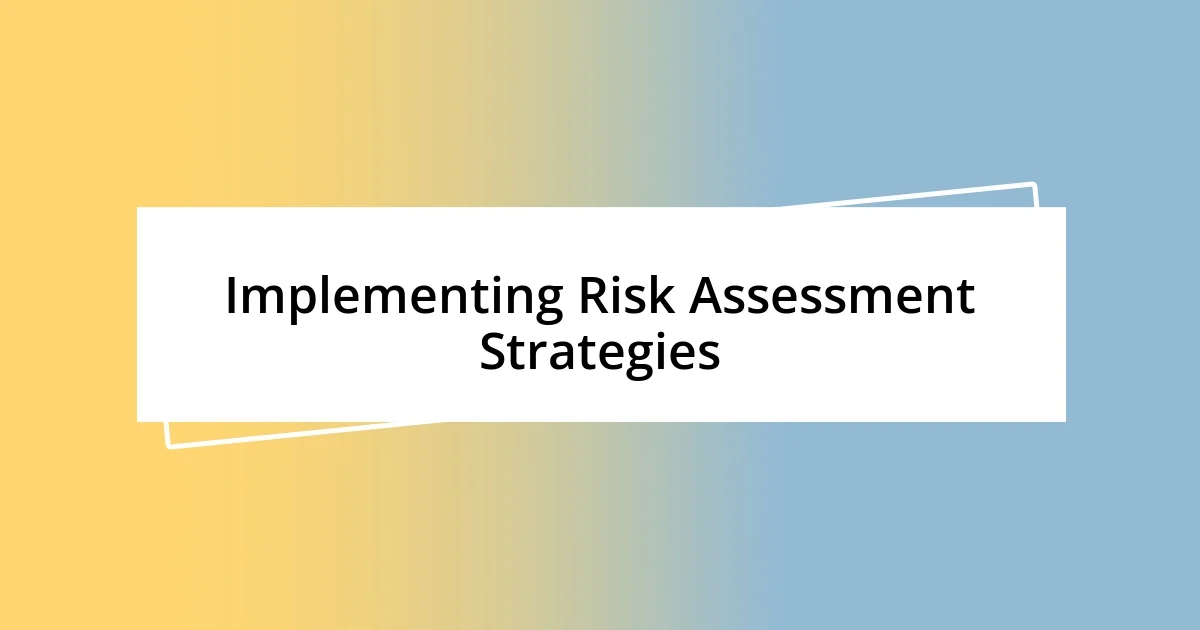
Implementing Risk Assessment Strategies
When it comes to implementing risk assessment strategies, I find that the first step is always identifying potential vulnerabilities within your cloud environment. For instance, I once participated in a risk assessment workshop, and it was eye-opening to realize how many blind spots we had around our data access points. Are we truly aware of all the ways our data could be compromised? Taking time to systematically analyze these risks is crucial; it empowers you to focus your resources where they matter most.
Next up is the process of prioritizing those risks. I vividly remember a project where, after assessing our vulnerabilities, we discovered certain third-party applications posed significant security threats. It felt daunting to confront this reality. But prioritizing allowed us to tackle the most pressing issues first. Have you taken the time to rank your risks? This step not only clarifies your action plan but also helps manage the anxiety that comes with knowing there are potential threats lurking.
Lastly, involving your team in the assessment process is something I’ve found to be invaluable. During a recent brainstorming session, it struck me how different perspectives can reveal risks I hadn’t even considered. This collective approach not only sparks creativity in problem-solving but also fosters a shared responsibility for security within the organization. Isn’t it amazing how collaboration can lighten the emotional load? When everyone feels like a stakeholder in protecting the data, it transforms risk assessment from a daunting task into a team effort that brings people together.
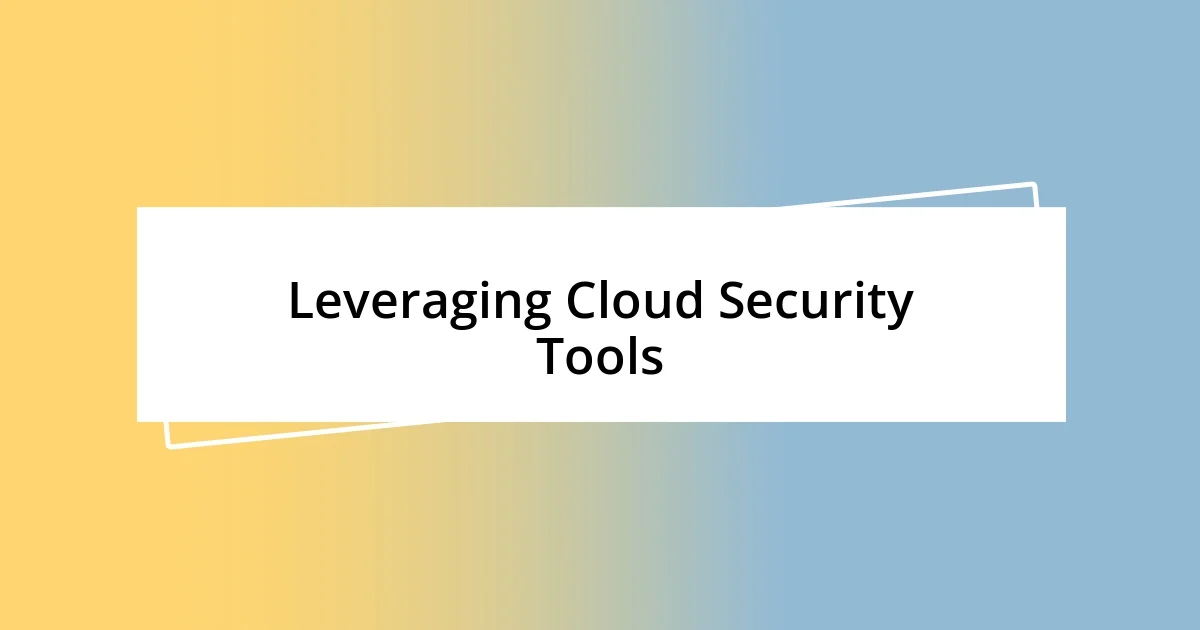
Leveraging Cloud Security Tools
I often find cloud security tools to be a game-changer in managing risks effectively. A couple of years ago, I implemented a suite of cloud security services in a project that involved financial transactions. The visibility these tools provided was incredible; I could monitor user activity in real-time. Have you ever experienced that sense of control? It’s reassuring to know that you can take immediate action if something doesn’t seem right.
In addition to monitoring, automation in cloud security tools saves significant time and reduces human error. I recall a time when my team was overwhelmed with manual processes to manage security configurations across multiple cloud instances. After we integrated automated compliance checks, we not only streamlined our operations, but it also made reporting far more straightforward. Isn’t it fascinating how technology can simplify complexities? Automation allows teams to focus on more strategic initiatives rather than getting bogged down in tedious tasks.
Furthermore, I believe using advanced analytics in cloud security tools can genuinely enhance threat detection. During a particularly intense period of targeted attacks, I leveraged machine learning algorithms that provided insights into unusual patterns of behavior among users. The results were eye-opening; these powerful analytics helped us act swiftly to mitigate potential breaches. If you’re not yet tapping into analytics, are you missing out on key insights? The ability to proactively identify threats reshapes how we approach cloud security, transforming our response from reactive to proactive.

Future Trends in Cloud Security
As I look into the future of cloud security, one trend that excites me is the increased integration of artificial intelligence (AI) and machine learning (ML). In a recent project, I interacted with a platform that utilized AI to analyze threat patterns and predict potential risks before they materialized. It felt almost like having a digital security assistant that was always a step ahead. Can you imagine the peace of mind that comes from knowing your security measures are proactive rather than reactive?
Moreover, I believe we’ll see a rise in zero-trust architecture as organizations embrace more robust security protocols. This principle operates under the assumption that threats could originate both outside and inside the network. I remember discussing this approach with a colleague who successfully implemented it in his organization. It made me rethink how I access sensitive data; it’s like locking every door in your house, no matter who’s inside. Have you considered how zero trust might reshape your security landscape?
Lastly, I’m really curious about the evolution of privacy regulations and how they’ll impact cloud security strategies. With growing concerns over data privacy, I anticipate organizations will need to align their safety protocols with compliance requirements more than ever. I recall an experience when navigating new regulations felt overwhelming, but it also served as a vital prompt to reassess our policies. Isn’t it intriguing how challenges can sometimes lead to stronger security frameworks? As these trends unfold, they’ll fundamentally alter how we think about and implement cloud security.












